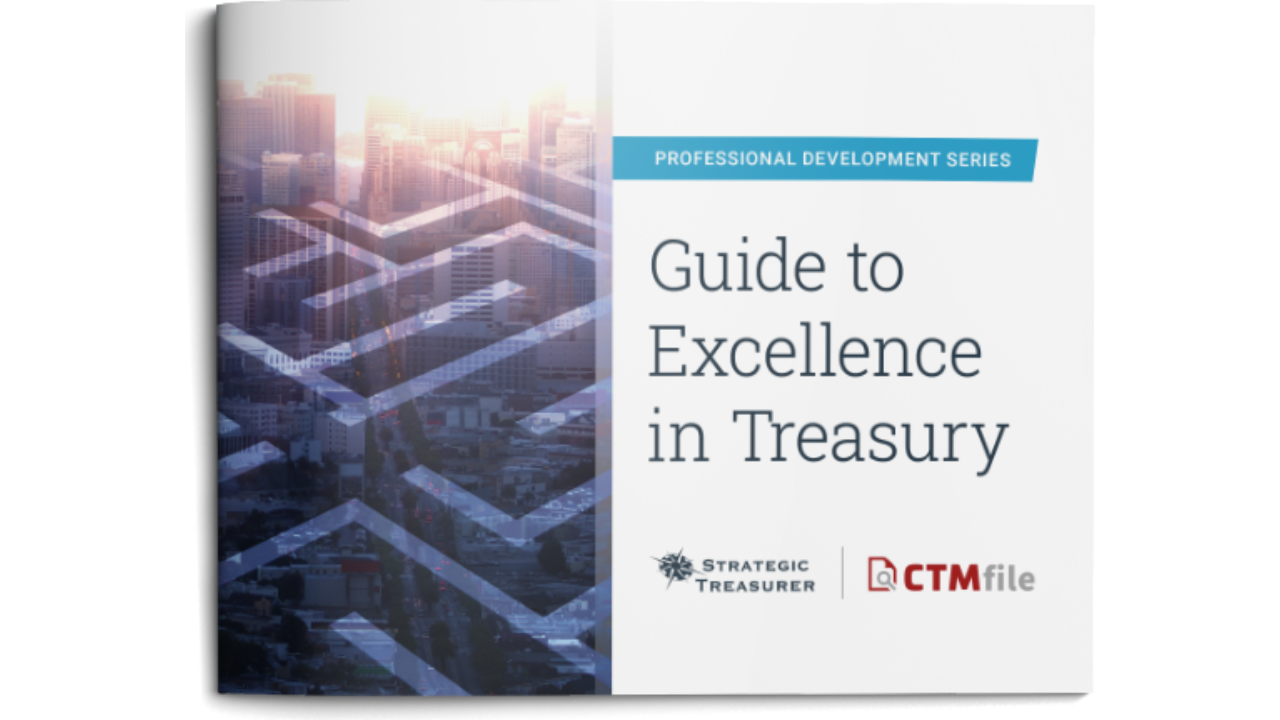
Session 99
Options for Traditional Debt Funding Structures
In today’s episode of the Treasury Update Podcast, Paul Galloway shares three examples of traditional debt funding structures. Listen in as he breaks down syndicated loans, senior debt, and revolvers. Learn what makes each of these financing tools unique and why treasurers may strategically choose one over the other.
Host:
Jonathan Jeffery, Strategic Treasurer


Speaker:
Paul Galloway, Strategic Treasurer


Episode Transcription - (Coffee Break Session Series) - Episode 99 - Options for Traditional Debt Funding Structures
Jonathan Jeffery 00:02
Welcome to the Treasury Update Podcast Coffee Break Sessions presented by Strategic Treasurer, the show where we cover foundational topics and core treasury issues in about the same amount of time it takes you to drink your cup of coffee. I’ll be your host, Jon, media production specialist here at Strategic Treasurer. So sit back, relax and enjoy the show. I am here with Paul Galloway for another Coffee Break Session. Welcome back to the show, Paul. How are you doing?
Paul Galloway 00:30
Doing good, Jon. Thanks for having me again.
Jonathan Jeffery 00:32
So we are moving away from our little series on CDs. We talked about what are callable CDs, brokered CDs, CD laddering, as well as just your traditional CDs. Now we’re going to move into traditional debt funding structures. Paul, would you walk us through a couple of different types of funding structures?
Paul Galloway 00:55
Yeah, sure. Thanks, Jon. The three I want to talk about are syndicated loans, senior debt and revolvers. A syndicated loan is a loan that’s made by a group of banks and non bank financials to a borrower. So non bank financials may include insurance companies or mutual funds, pension funds, retirement plans. It’s like a group of people that come together to lend to a borrower. Senior debt is a loan that a company makes and must repay, you know, before any other obligation. So it’s senior, when you think about in the event that a company was to, let’s say, go bankrupt. That’s the last thing you want to have happen. The pecking order in terms of who receives their funding back is based on seniority. Senior debt is called senior debt for a reason, because it’ssenior toeverything else, so senior debt gets repaid for before other debtors get repaid. And that is a common form of debt funding that’s utilized by quite a few publicly traded companies, other companies out there that have senior type debt instruments. The other debt funding structure I want to talk about was revolvers. And revolvers is a little bit different than like a syndicated loan or senior debt, syndicated loans and senior debt they go out, they they get a certain amount of funding, they get all that today, once they close on it, they receive all those funds, they pay back interest in principal over a period of time and it’s done. Revolvers are different, it’s kind of like having an extended line of credit over a period of time. So five years, so just make it simple. And say it’s five years, ever revolving facility where an organization can either borrow some or all of the amount that they’re allowed to, per the terms of the agreement. So this revolving line of credit, let’s say $200 million, well, they can borrow that from time to time. So let’s say they borrow 50 million today. And they repay that back six months later, if they wanted to borrow $100 million, you know, nine months from now, they can borrow $100 million, as long as they pay back the $50 million of the 100 million that they have in total facility. So they call it revolving because they can borrow, pay it back, borrow, pay it back, borrow and pay it back. They do have to pay fees along the way if if they aren’t using the facility. So revolver is kind of unique play on debt funding, it’s commonly used by quite a few companies. It’s something when I was a practitioner, I had a revolving facility that was in place. And, you know, it’s just something that you have as part of your typical capital management.
Jonathan Jeffery 03:52
So, revolver is is similar to a personal credit card versus a construction loan to put it in a pool or something.
Paul Galloway 04:01
That’s a great way to look at it. It’s it’s like having a credit card except for, you know, a company.
Jonathan Jeffery 04:07
Are fees with revolvers higher than other ways of securing debt.
Paul Galloway 04:12
Yeah, when you think about this pecking order I was talking about earlier, you know, senior debt, you know, when if you were to just say that everything else was equal. And of course, this is just making some very broad assumptions. Just to give you an idea in terms of costs associated with these different types of facilities, senior debt, in theory would cost you less than the, you know, revolving facility. So the revolver is going to have a couple pieces tied to it because it’s going to have this unutilized piece or capacity fee that you pay for just having the line of credit there in place. At the point that you borrow the funds. You also have some additional fees that are incurred. So an interest payment that you have to make an addition to the facility fees themselves. So you tack on some additional fees associated with it. And what happens is, is that when it comes to borrowing and the structure again, if, if you’re going to be paid before anybody else, if something goes wrong, then you have a little bit more security than somebody else that doesn’t have that, you know, that doesn’t stack up in there. So if you’re taking on more risk as a lender, you typically charge higher interest rates are higher fees are something associated to make up for the risk associated with the loan that, hey, you might not get repaid, if something goes bad. So fees can can be more depending on the particular structure. And that’s assuming you know that all things are held constant and the same. If there’s higher risk of not getting repaid, then there’s a higher cost of capital associated with getting that particular funding.
Jonathan Jeffery 04:20
So the cost can’t be the only thing you consider, though, right? Otherwise, everyone would always just go for one type of loan, or one type of debt. What things should should people be thinking about when they’re looking at these three options?
Paul Galloway 06:20
Yeah, so that’s, that’s a, that’s a great question. Because when it comes to capital management, you’re really kind of looking at a variety of things associated with how you raise capital to fund the organization. We’ve talked about this before another Coffee Break Sessions, and you can think about equity. People might think of, you know, like stock stock being equity in a company. So this is a way to raise capital, you go in the open market. So you’re publicly traded on the open market, you raise capital through issuance of stock, that’s equity. The other side is what we’re talking about today, the debt funding. Well, in the event that you go bankrupt, and you have to pay back all your debtors, well, common stockholders are at the bottom, unlike senior debt, they’re at the top. So senior debt gets paid first, who gets paid last equity holders? Well, the likelihood of equity holders being paid back is a lot less than senior debt, right. So a cost of capital associated with equity is much higher than the cost of capital. So these are associated with senior debt. But when a treasurer is looking at capital management overall, they’re looking for a way to leverage the overall return and the cost of capital associated with funding operations for whether it’s acquisition or organic growth or otherwise, creating new products. They’re looking to minimize the overall weighted average cost of capital. And so they’ll do that with a mix of funding structures. And so that comes into play with these funding structures, like we’re talking about syndicated loans, senior debt revolvers, lenders will put what’s called on their covenants and covenants can restrict an organization from doing something, or it can require an organization to do something. Some of these structures have these covenants that are associated with a lending facility that they put in place. And so treasures got to take that into consideration. The CFO and the CEO, the company will also think about those pieces as well. So there are some aspects around the structure of the loans themselves that they engage in that they’ll consider as well. So cost of capital, overall capital management, covenants, these things all come into play, when you’re thinking about how or what you’re going to utilize to fund company operations.
Jonathan Jeffery 08:51
Are there any other risks that we haven’t, haven’t talked about yet?
Paul Galloway 08:55
You know, obviously, we talked about the idea that company potentially could fail, the lender might not get back the amount of money that they lent out to the organization in those events, the risks that the lender takes on they are compensated by the interest that’s charged on the funding vehicle. And so that’s, that’s the risk that they’re being paid to accept. The borrower also thinks about, you know, what are the risks associated with having all my eggs in one basket in terms of somebody that’s lending to me, and so treasures also think about being able to share they call it share of wallet being able to spread the lending that they engage in across more than one counterparty so they manage counterparties. So you have to manage the relationships and through the management of the relationships you consider the risks associated with it. Sometimes having these relationships allow companies to get into markets or sell products or services in places they otherwise might not have access to. You know, when you think of risks, it’s kind of both sides lenders and borrowers, you’ll get to look at it from both perspectives because both sides are taking certain amount of risk associated with engaging in debt funding.
Jonathan Jeffery 10:23
So if anyone is looking for more information on syndicated loans, senior debt, or revolving debt, do you have any resources that they should be looking at?
Paul Galloway 10:32
A great place to go is to your banks. If you don’t have regular meetings with your banks, or if you’re interested ingetting more information, call up your banks, talk to your bankers, they’ll be more than happy to talk to you about these different options. They’ll provide you with more than information, not only on the structure, but what’s going on out there in the market. So we’ll talk about precedent transactions, things that happen before things that they’re hearing out in the market trends. They’ll tell you kind of an idea of where spreads are at where interest rates are at so you can start getting an idea of costs. Banks are really a great resource for you to utilize. So if you want information go to your bankers.
Jonathan Jeffery 11:17
Well, thank you, Paul, for sharing some information on traditional debt funding structures.
Paul Galloway 11:22
You bet.
Jonathan Jeffery 11:23
And to our listeners, remember to tune back in every first and third Thursday of the month for a new Coffee Break Session. Have a good day.
Announcer 11:35
This podcast is provided for informational purposes only, and statements made by Strategic Treasurer LLC on this podcast are not intended as legal, business, consulting, or tax advice. For more information, visit and bookmark StrategicTreasurer.com.
Whether you’re aiming to become a treasurer, have just landed the job, or have held the position for years but are still seeking ways to improve and grow, this guidebook should have some ideas that will help you and your organization thrive.
What is the debt market? Coffee Break Session Host Jason Campbell catches up with Strategic Treasurer’s Senior Advisor Paul Galloway to chat about the debt market. They discuss who the players are, how issuers and investors monitor the debt markets, and the difference in perspectives. Listen in and learn a little bit about the debt market.




